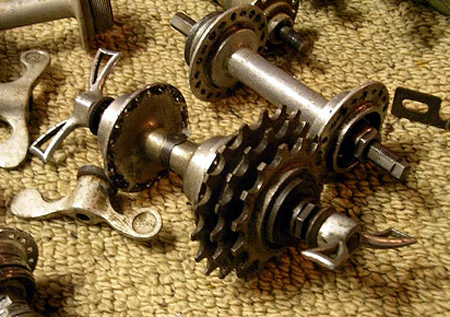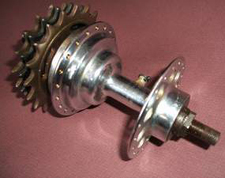Bayliss-Wiley Unit Hub: Ahead of its time
 Tue, April 5, 2011
Tue, April 5, 2011 
My first serious lightweight bike was a modest Dawes made of Reynolds 531 tubing. It had a cottered steel crank with a single chainring, and a Simplex derailleur with 3x1/8 inch sprockets.
The rear hub was a Bayliss-Wiley “Unit” hub as it was known. (Pictured above.) Freewheels had always been a separate item that screwed to the hub, this one had the freewheel built into the hub as a single unit, hence its name.
Today we call this a cassette hub and is the standard equipment on most high end and even moderate lightweight bikes.
The Bayliss-Wiley Unit hub was introduced in 1938, and was produced until 1957. Not particularly lightweight it was never considered to be racing equipment, but was used by club cyclists, tourists, and young kids like me who were just starting out.
Looking back it was really ahead of its time and it would be 30 years later that the Japanese company Suntour introduced another, and failed. It wasn’t until the top two manufacturers, Shimano and Campagnolo introduced their cassette hubs that people took them seriously.
The freewheel was always considered an item that would wear out long before the hub, therefore at one time it made sense to have it be a separate component that could be unscrewed from the hub and replaced.
 It wasn’t until freewheels went beyond six sprockets to 7, 8, 9, and 10, that an all in one unit or cassette hub was considered practical.
It wasn’t until freewheels went beyond six sprockets to 7, 8, 9, and 10, that an all in one unit or cassette hub was considered practical.
The Bayliss-Wiley Company was located in Tyseley, Birmingham, England and was founded by Cecil Bayliss and Arthur Wiley in 1919.
The company had what we would call today a niche marlet; they produced inexpensive but high quality bicycle components. Bayliss-Wiley kept the British working man on the road, back in the day when the bicycle was often the only form of transport for the working class.
They primarily made hubs, single speed freewheels, and bottom brackets; the parts that wore out and needed regular replacement. The company thrived through the 1920s, 30s and 40s, but not surprisingly declined in the late 1950s, when the British working man abandoned the bicycle and started buying cars for the first time.
Taken over by Reynold Chains Ltd., the Bayliss-Wiley name finally disappeared in 1969. One of the most recognizable brand names when I started cycling in the 1950s, but not too many of today's generation will have heard of Bayliss-Wiley even in the UK.
You can read more on Ebykr.com























Reader Comments (6)
Awesome history Dave - thanks for sharing!
And just think I feel like I am going old school by having a 10 speed built up!
Thanks again.
Dave, Another hit from the past, that is standard on most modern bikes is the headclip. My 1937 Claud Butler has one with a single bolt to tighten. Very much like the ones on the bikes of to-day. John Crump
I don't want to talk out of turn here, since you've forgotten more than I know about bicycles Dave, but, at least in the case of modern 7 speed freehub and cassette setups the freehub is not built into the hub, it's removable. At least this has been my experience with two Shimano 7 speed hubs.
To remove the freehub, remove the cassette, remove the axle, then using a 10mm allen key remove the hollow bolt in the centre of the freehub which attaches it to the wheel hub.
Still a very interesting article. It just goes to show - everything old is new again.
lemmiwinks,
Thanks, I've never taken one apart so I did not know that.
Dave
Your new blog looks much nicer than your old!
Is that photo of the same sprockets which you reference?
Thanks,
Sam from Triathlon bikes for beginners
I have a BW double-fixed hub on my desk as a paperweight, retired after riding through many English winters. A thing of beauty.
May the day soon come when the main mode of transportation will once again be the bicyle